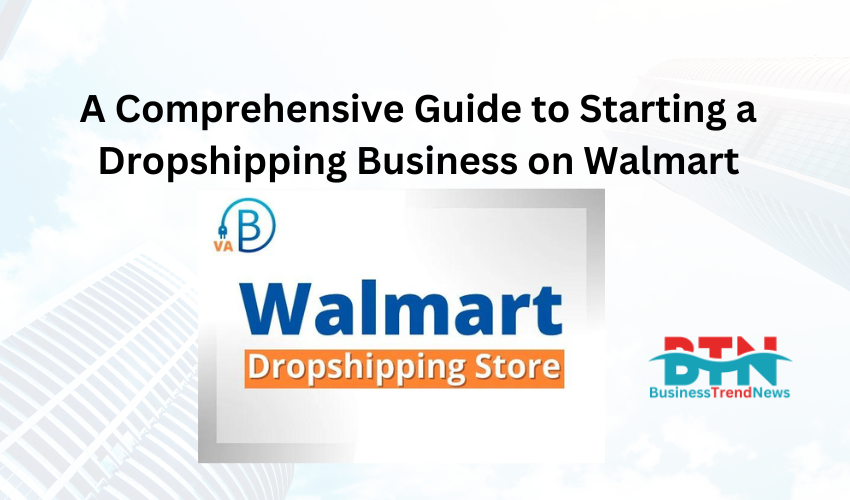![]()
Introduction
Dropshipping has become a popular business model for entrepreneurs looking to start an e-commerce business with minimal upfront investment. By leveraging the power of platforms like Walmart, sellers can reach millions of customers without the need to hold inventory. In this comprehensive guide, we’ll explore the ins and outs of starting a dropshipping business on Walmart, from setting up your seller account to optimizing your listings for maximum sales. Whether you’re a seasoned e-commerce professional or a newcomer, this guide will provide valuable insights to help you succeed in the competitive world of dropshipping.
What is Dropshipping?
Dropshipping is a retail fulfillment method where a store doesn’t keep the products it sells in stock. Instead, when you sell a product, you purchase the item from a third-party supplier and have it shipped directly to the customer. This means you don’t have to manage inventory, which reduces overhead costs and risks.
The main benefits of dropshipping include:
- Low Startup Costs: No need to invest in inventory upfront.
- Easy to Start: You can set up your business quickly without dealing with logistics.
- Scalability: As your business grows, you can easily scale without worrying about warehousing and fulfillment.
Why Walmart for Dropshipping?
Walmart is one of the largest retailers in the world, with millions of daily visitors to its online platform. Dropshipping on Walmart offers several advantages:
- Massive Customer Base: Access to millions of potential customers.
- Trust and Credibility: Walmart’s brand is trusted by consumers, which can increase your conversion rates.
- Diverse Product Categories: Walmart’s vast range of categories allows you to sell a wide variety of products.
- Walmart Marketplace: Walmart’s marketplace is an increasingly popular platform for third-party sellers, offering a great opportunity for dropshipping.
Getting Started with Walmart Dropshipping
Step 1: Apply to Become a Walmart Marketplace Seller
Before you can start dropshipping on Walmart, you need to apply to become a seller on the Walmart Marketplace. The application process is straightforward but selective. Here’s what you need to do:
- Prepare Your Business Information:
- Business Name
- Tax Identification Number (TIN)
- Employer Identification Number (EIN)
- Address and contact details
- Complete the Application:
- Visit the Walmart Marketplace Application page and fill out the application form.
- Provide detailed information about your business, including your experience, product catalog, and fulfillment capabilities.
- Wait for Approval:
- Walmart carefully reviews each application. It may take a few weeks to receive a response. Ensure your business meets Walmart’s standards, such as having a strong e-commerce history and good customer service ratings.
Step 2: Set Up Your Walmart Seller Account
Once approved, you’ll need to set up your Walmart Seller Account:
- Account Registration:
- Register your seller account and complete your profile. This includes setting up payment information, tax settings, and shipping methods.
- Walmart Seller Center:
- Familiarize yourself with the Walmart Seller Center, the platform where you’ll manage your listings, orders, and performance metrics.
Step 3: Find Reliable Dropshipping Suppliers
Your suppliers are the backbone of your dropshipping business. Choosing the right suppliers is crucial for success. Consider the following when selecting suppliers:
- Supplier Reliability: Ensure the supplier consistently delivers products on time and maintains good product quality.
- Product Selection: Choose suppliers with a wide range of products that fit your niche.
- Pricing and Margins: Evaluate the cost of goods to ensure you can maintain healthy profit margins after Walmart’s fees.
- Shipping Times: Verify that the supplier can meet Walmart’s shipping standards, as fast and reliable shipping is essential for customer satisfaction.
Popular platforms for finding dropshipping suppliers include AliExpress, Oberlo, SaleHoo, and Spocket. Some suppliers specialize in dropshipping to U.S. customers, which can help reduce shipping times and improve customer satisfaction.
Step 4: List Your Products on Walmart
Now that your account is set up and you’ve secured suppliers, it’s time to list your products on Walmart:
- Product Listings:
- Create product listings in the Walmart Seller Center. Ensure that your product titles, descriptions, and images are optimized for both Walmart’s search algorithm and your customers.
- Use high-quality images and detailed descriptions to attract buyers. Make sure to include key features, benefits, and specifications.
- Price Competitively:
- Research competitors’ pricing on Walmart and other platforms to ensure your prices are competitive.
- Consider using dynamic pricing tools to automatically adjust prices based on market conditions.
- Optimize for SEO:
- Use relevant keywords in your product titles, descriptions, and tags to improve visibility in Walmart’s search results.
- Consider hiring an SEO expert if you’re unfamiliar with keyword research and on-page optimization techniques.
Step 5: Manage Orders and Customer Service
As orders start coming in, managing them effectively is crucial to maintaining your seller rating and ensuring customer satisfaction:
- Order Fulfillment:
- When an order is placed, forward it to your supplier for fulfillment. Ensure the supplier ships the product directly to the customer with minimal delay.
- Track shipments and update customers with tracking information to keep them informed.
- Customer Service:
- Respond promptly to customer inquiries and resolve issues professionally.
- Walmart places a high emphasis on customer service, so maintaining a high level of responsiveness is critical to your success.
- Returns and Refunds:
- Set up a clear returns policy that complies with Walmart’s guidelines. Work with your suppliers to manage returns efficiently.
Step 6: Monitor and Optimize Performance
Success in dropshipping on Walmart isn’t just about setting up shop; it’s about continuous optimization and improvement:
- Analyze Sales Data:
- Regularly review your sales data in the Walmart Seller Center. Identify trends, best-selling products, and areas for improvement.
- Use analytics tools to understand customer behavior and adjust your strategies accordingly.
- Optimize Listings:
- A/B test different product titles, images, and descriptions to see what resonates best with your audience.
- Continuously refine your listings to improve conversion rates.
- Manage Inventory:
- Although you don’t hold inventory, ensure your suppliers have adequate stock levels to meet customer demand.
- Set up alerts or automated systems to monitor inventory levels and avoid stockouts.
- Expand Your Product Line:
- As your business grows, consider adding new products to your catalog. Research trending products and explore new niches.
- Diversifying your product line can help you reach a broader audience and increase sales.
Best Practices for Dropshipping on Walmart
1. Focus on Customer Experience
Customer experience is paramount in e-commerce, and Walmart is no exception. Focus on providing excellent customer service, fast shipping, and clear communication to build a strong reputation on the platform.
2. Leverage Walmart’s Tools and Resources
Walmart offers a variety of tools and resources to help sellers succeed. Take advantage of Walmart Fulfillment Services (WFS) if you need additional support with logistics. Use Walmart’s advertising options to boost visibility and drive sales.
3. Stay Compliant with Walmart’s Policies
Walmart has strict guidelines for sellers to ensure a high-quality shopping experience for customers. Familiarize yourself with these policies and ensure your business complies with them. This includes adhering to pricing policies, managing customer feedback, and maintaining accurate product listings.
4. Build Strong Supplier Relationships
Your suppliers play a critical role in your dropshipping business. Build strong relationships with reliable suppliers to ensure consistent product quality and timely deliveries. Consider working with multiple suppliers to diversify your product offerings and reduce risk.
5. Keep Up with Industry Trends
The e-commerce industry is constantly evolving, and staying informed about trends is essential. Follow industry news, participate in forums, and network with other dropshippers to stay ahead of the competition.
6. Invest in Marketing
While Walmart provides a massive customer base, it’s still important to invest in marketing to drive traffic to your listings. Consider running paid ads on social media, search engines, or even on Walmart’s own platform. Content marketing, email marketing, and influencer partnerships can also help you build brand awareness and increase sales.
Challenges of Dropshipping on Walmart
While dropshipping on Walmart offers many opportunities, there are also challenges to consider:
1. High Competition
Walmart’s marketplace is competitive, with many sellers vying for the same customers. To stand out, you’ll need to differentiate your products and offer competitive prices. Continuous optimization of your listings and marketing strategies is necessary to maintain a competitive edge.
2. Supplier Dependence
Your dropshipping business relies heavily on your suppliers. Any issues with suppliers, such as stockouts, shipping delays, or quality control problems, can directly impact your business. It’s crucial to choose reliable suppliers and have contingency plans in place.
3. Thin Profit Margins
Dropshipping typically operates on thin profit margins. After accounting for product costs, shipping fees, and Walmart’s marketplace fees, your profit margins may be tight. To succeed, you’ll need to carefully manage your costs and focus on high-volume sales or premium products.
4. Limited Control Over Branding
Since your products are shipped directly from suppliers to customers, you have limited control over the packaging and branding. This can make it challenging to create a unique brand experience. Consider working with suppliers who offer white-label or private-label options to enhance your brand presence.
5. Compliance and Regulation
Walmart has strict rules for sellers, and failing to comply with these regulations can lead to account suspension or termination. Stay informed about Walmart’s policies and industry regulations to avoid any compliance issues.
Conclusion
Starting a dropshipping business on Walmart can be a lucrative opportunity for entrepreneurs looking to enter the e-commerce space. With Walmart’s vast customer base and trusted brand, dropshipping on this platform offers the potential for significant growth and success.
However, like any business, it requires careful planning, ongoing management, and a commitment to providing excellent customer service. By following the steps outlined in this guide and staying informed about industry trends, you can build a successful dropshipping business on Walmart and achieve your entrepreneurial goals.
Remember, success doesn’t happen overnight. Stay patient, keep learning, and continue optimizing your business for long-term growth. With the right approach, your Walmart dropshipping business can thrive in the competitive e-commerce landscape.



